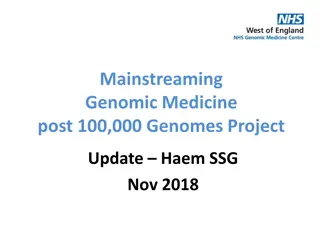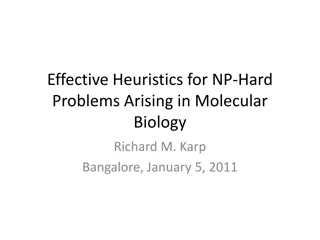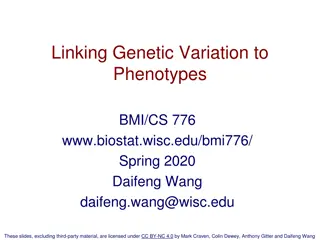Insights into Genome Assembly and Shotgun Sequencing
Explore the world of genome assembly, shotgun sequencing, and the fundamental concepts behind deriving genomes from large sets of sequencing reads. Learn about the complexity and core algorithms involved in contemporary genome assembly processes. Discover how the shotgun concept has revolutionized g
2 views • 66 slides
Investigating Human Papillomavirus Genomes in Cervical Neoplasms
This project focuses on studying the Human Papillomavirus (HPV) genome's association with disease progression and treatment response in cervical neoplasms and cancer. The research aims to genotype high-risk HPVs in healthy and diseased cervix, identify prevalent genotypes, detect genotype drift, cha
1 views • 13 slides
Genetic Control of Metabolism in Microbes: Enhancing Traits for Biotechnology
Exploring the genetic control of metabolism in microbes, focusing on wild type organisms and the process of strain improvement through mutagenesis, selective breeding, and recombinant DNA techniques. The potential benefits and challenges of altering microbial genomes for biotechnological application
0 views • 27 slides
Transformative Power of Sequencing in Molecular Biology
The falling costs of sequencing have revolutionized various fields like genetics, genomics, cell biology, microbiology, and evolutionary biology. Sequencing data has enabled us to understand genomes, revolutionize cell biology techniques, conduct comparative genomics, population genomics, and metage
1 views • 31 slides
The Origin of Viruses: Theories and Evidence
Viruses are acellular parasites with a complex replication mechanism. Studies on their origin present challenges due to the lack of fossils. Three main hypotheses include regressive, cellular origin, and co-evolution. The regressive hypothesis suggests viruses originated from complex ancestors that
2 views • 25 slides
Understanding Transcription Factors and Regulatory Sequences in Gene Expression
Transcription factors play a crucial role in gene expression by controlling the recruitment of RNA polymerase. Promoter regions contain sequences like CAAT box and TATA box that regulate transcription by binding proteins. Consensus sequences are conserved patterns in the genome with various biologic
2 views • 10 slides
Exploring the Personal Life Perspective in Sociology
This content delves into the Personal Life Perspective in sociology, which emphasizes the individual's view and meanings in the context of family dynamics. It contrasts with structural theories by focusing on personal relationships and individual actions rather than societal structures, highlighting
0 views • 14 slides
Understanding Personal Letters
Personal letters are informal messages sent to close acquaintances to share personal experiences, express apologies, extend invitations, or offer congratulations. This form of communication typically involves the writer's full address, the date, recipient's details, a greeting, subject line (optiona
1 views • 17 slides
Viral Genome Replication Strategies and Mechanisms
Viruses utilize different replication strategies to ensure the replication of viral genomes, packaging into virions, and potentially altering the host cell's structure or function. These strategies are vital for the virus to operate effectively within the host cell's constraints. The replication pro
0 views • 15 slides
Examination of Personal Information Protection in Victorian Universities
The report discusses the importance of protecting personal information in Victorian universities due to the high volumes of sensitive data they hold. It emphasizes the responsibility to safeguard personal information through a risk-based approach, as outlined in the Privacy and Data Protection Act 2
0 views • 17 slides
Understanding Transcription and Translation of Virus Genome
The lecture covers the transcription and translation processes of virus genomes, including the Baltimore classification system, transcription control in eukaryotes, and the role of transcription factors in gene expression. It explores how different viruses replicate based on their genome type and me
0 views • 14 slides
Understanding the EU General Data Protection Regulation (EU GDPR)
The EU General Data Protection Regulation (EU GDPR) is a comprehensive regulation that governs the processing of personal data of individuals in the EU. It came into effect on May 25, 2018, and applies to all organizations handling personal data of EU residents. The regulation includes key definitio
4 views • 21 slides
Engaging Every Church Member in Personal Outreach for Growth
Encouraging total member involvement and personal ministries is key for church growth. When every member is engaged in personal outreach, the church has the potential to expand. Through intentional acts of kindness, compassionate service, and health ministry, hearts can be prepared to receive the go
1 views • 101 slides
Personal Development: Creating a Personal Development Plan for Career Success
Explore the essential components of personal development with Ms. Minnie in this insightful lesson. Discover the importance of a Personal Development Plan (PDP), conducting skills audits, and enhancing key skills needed in various working environments. Uncover the significance of lifelong learning a
0 views • 30 slides
Overview of Personal Data Protection Bill, 2018
The Personal Data Protection Bill, 2018 addresses concerns regarding personal privacy amidst advancing technology. It grants rights to individuals and mandates transparency in handling personal information. The Bill stems from the recognition of the right to privacy as fundamental. It defines terms
0 views • 23 slides
Exploring the Evolution of Molecular Biology: From DNA Discovery to Genome Complexity
Uncover the fascinating journey of molecular biology, tracing key milestones from the discovery of DNA to the intricate structure of genes and genomes. Dive into historical breakthroughs, such as understanding the role of genes in producing proteins, the double helix structure of DNA, and the comple
2 views • 30 slides
Explore Cromwell and WDL Bioinformatics Workflows
Discover the world of Cromwell and WDL bioinformatics workflows at any scale, with emphasis on the scalability and flexibility of the execution engine. Learn about the Workflow Description Language and basic plumbing concepts. Unveil the multiple backends for maximum flexibility in Cromwell's execut
0 views • 14 slides
Understanding Chromosomes: Key Components, Functions, and Significance
Chromosomes, essential in mitosis and meiosis, are condensed forms of DNA vital for heredity, mutation, and evolution. Learn about their structure, role in inheritance, and impact on species development through historical discoveries. Discover the importance of chromosome sets and genomes in gametic
0 views • 38 slides
Evolution of Personal Assistance for People with Disabilities in Slovenia
Personal assistance for people with disabilities in Slovenia has evolved over the years. Before 2019, the program faced challenges like insufficient funding, lack of candidates for personal assistant jobs, and long waiting lists. However, since 2019, personal assistance has become a legal right, wit
0 views • 13 slides
Understanding Sequence Alignment in Next-Generation Sequencing Data
Sequence alignment plays a crucial role in analyzing Next-Generation Sequencing (NGS) data by identifying similarities between DNA, RNA, or protein sequences. Global and local alignment methods are used to arrange sequences and locate fragments derived from specific genes or transcripts. Challenges
0 views • 31 slides
Understanding Evolutionary Algorithms in Computer Science
Evolutionary algorithms, particularly genetic algorithms, simulate natural evolution to optimize parameters and discover new solutions. By creating genomes representing potential solutions and using genetic operators like mutation and crossover, these algorithms populate a search space, conduct loca
0 views • 33 slides
Analysis of Admixed Human Genomes: Methods and Challenges
Explore the methods and challenges involved in analyzing admixed human genomes, with a focus on the impact of gene flow on genetic diversity patterns. Learn about the underrepresentation of admixed populations in medical genetics and the goals of developing detailed quantitative models of human evol
0 views • 27 slides
Understanding Circularly Permuted Phage Genomes
Some phages have circularly permuted genomes where a linear concatamer of DNA is synthesized, filled into a phage head, and cut when full, ensuring continuous gene presence. This leads to no defined ends, no primer walks, and assembly into large contigs rather than distinct physical ends. This guide
0 views • 28 slides
Genomic Imputation Pipeline Overview
This document outlines a genomic imputation pipeline for multiple GWAS studies using reference panels such as 1000 Genomes Phase I data. It covers steps like data matching, phasing, and imputation using tools like Beagle and Minimac. The expected output includes imputed dosages and quality measures.
0 views • 6 slides
Genetics 210: Personalized Medicine and Genomics Course Overview
Genetics 210 is a course focused on personalized medicine and genomics designed for MDs, PhDs, and curious students. The course covers topics such as genotyping, informed consent, and exploring specific genetic loci. Students engage in projects like annotating genomes and debating FDA regulations. T
0 views • 24 slides
Importance of Functional Annotation of Animal Genomes in NIH Research
Functional Annotation of Animal Genomes (FAANG) is crucial for associating sequence variation with quantitative phenotypes in domestic animals, serving as important models for human health, disease, and ecology. The NIH actively participates in various genome projects involving cattle, horses, and c
0 views • 10 slides
Applications of Transgenic Animals in Biotechnology and Cloning
Cloning in animals offers the advantage of indefinite duplication of elite genotypes without the genetic risks of meiosis. Transgenic animals, genetically modified to carry foreign genes, play a crucial role in genetic research and the development of livestock with desired traits. Methods like DNA m
0 views • 13 slides
Decades of Marine RNA Virosphere Research
Research spanning over two decades has delved deep into the marine RNA virosphere, shedding light on the complex marine ecosystem and the characteristics of RNA viruses. Discoveries in deep marine virus taxonomy have led to significant taxonomic changes and advancements in virus classification and g
0 views • 10 slides
Mainstreaming Genomic Medicine: 100,000 Genomes Project Update
The Mainstreaming Genomic Medicine post provides insights into the background and progress of the 100,000 Genomes Project, including details on genetic vs. genomic testing, the setup of NHS Genomic Medicine Centres, types of cancer included, and samples taken. It covers the project's inception, key
0 views • 19 slides
Insights into NP-Hard Problems in Molecular Biology and Genetics
Understanding the complexity of NP-Hard Problems arising in molecular biology and genetics is crucial. These problems involve genome sequencing, global alignment of multiple genomes, identifying relations through genome comparison, discovering dysregulated pathways in human diseases, and finding spe
0 views • 24 slides
Basics of Genetics Engineering: Introduction to DNA and Gene Expression
Exploring the fundamentals of genetics engineering, this lecture covers topics such as DNA structure, gene expression, gene function, genome, mutation, recombination, and genetic modification. Understand the significance of DNA, genes, and the processes involved in gene expression. Dive into the wor
0 views • 20 slides
Regulation of Non-Personal Data and Its Scope
The discussion delves into the expanding scope of legal instruments surrounding personal data regulation, including the definitions and implications of identifiable natural persons, processing of personal data, and metadata. It explores the necessity of regulating non-personal data alongside persona
0 views • 9 slides
Gene Coding Potential Analysis for Multiple Genes
Analysis of coding potential for six genes revealed details such as start positions, gene lengths, coding potential scores, and functional predictions. Genes exhibit various characteristics like RBS values, Blast results, and Family of unknown function classifications based on multiple analyses like
0 views • 25 slides
Understanding Mutations and Natural Selection in Genomes
Explore how mutations impact survival and how genomes record these changes, distinguishing between functional and nonfunctional sequences. Learn about the effects of mutations on organism survival and the role of natural selection in shaping genetic variability.
0 views • 11 slides
Investigating Allelic Bias in Personal Genomes
This study delves into allelic bias in personal genomes, examining the influence of various factors such as sequencing datasets, removal of reads with allelic bias, and the impact on allele-specific single nucleotide variants (AS SNVs). The revised AlleleDB pipeline proposed includes steps for const
0 views • 6 slides
Strata Corporation Obligations under Personal Information Protection Act
The presentation discusses the obligations of strata corporations under the Personal Information Protection Act (PIPA), focusing on privacy guidelines, objectives of PIPA, definition of personal information, and rights of owners and tenants regarding their personal information. It also outlines the
0 views • 37 slides
Enhancing Academic Support through Personal Tutoring System
The Personal Tutoring System focuses on enhancing academic guidance, promoting graduate attributes, and fostering a sense of belonging within an academic community. It integrates personal and pastoral support while providing online resources for staff and students. The system outlines roles and resp
0 views • 15 slides
Understanding Human Genetic Variation and Its Implications
These slides explore the connection between genetic variations and phenotypes, focusing on how the human genome varies between individuals, identifying associations with phenotypes/diseases, and the impact of sequencing technologies on reading the genome. The evolution of projects like HapMap and th
0 views • 35 slides
My Personal Spacer – Live the Difference with Your Personal Space
Introducing My Personal Spacer, a unique invention designed to provide individuals with their personal space in a crowded world where diseases are prevalent. This innovative device enables users to maintain a comfortable distance from others without having to verbally express it. With the slogan "I
0 views • 9 slides
Machine Learning Approach for Hierarchical Classification of Transposable Elements
This study presents a machine learning approach for the hierarchical classification of transposable elements (TEs) based on pre-annotated DNA sequences. The research includes data collection, feature extraction using k-mers, and classification approaches. Proper categorization of TEs is crucial for
0 views • 18 slides







































